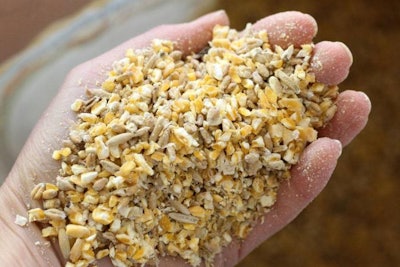
Take a bowl full of shelled peanuts, add some heavy pebbles in the mix and then shake the whole thing until your arm is ready to fall off. What do you get? Peanuts floating atop a layer of pebbles at the bottom. So, yes, in theory, too much handling of feed can cause it to separate. This is particularly true when feed is composed of ingredients of highly variable particle size and (or) specific density. It is also more possible to happen in feed handled in bulk as opposed to feed in bags. The problem is acute in species, like poultry, that can pick and choose, or those that consume small quantities in each meal, like most young animals. Pelleting removes this potential problem, so it is a cause of concern only for meal-type feeds.
In practical terms, however, this phenomenon is observed very rarely, although it is a frequent question and concern among those producers who mix their own feed in meal form at their home installations. But, again, it requires a lot of effort and a tremendous combination of factors for well-mixed feed to separate. A clear sign of unmixed feed is the accumulation of fine particles at the corners of feeders. In liquid feeding systems, when the "soup" disintegrates immediately into floating and sinking fractions, this is a sign that the feed needs reformulation to stay "in suspension" longer so that all animals consume the same complete diet.
Although feed separation is an infrequent cause of concern, it is bad mixing habits that can cause frequent headaches. Feed that has not been mixed properly is as bad, or even worse, than feed that starts to separate from too much handling. Bad mixing is not so uncommon among home mixers, although some severe cases can be seen in large commercial mills when pressured for production.

















